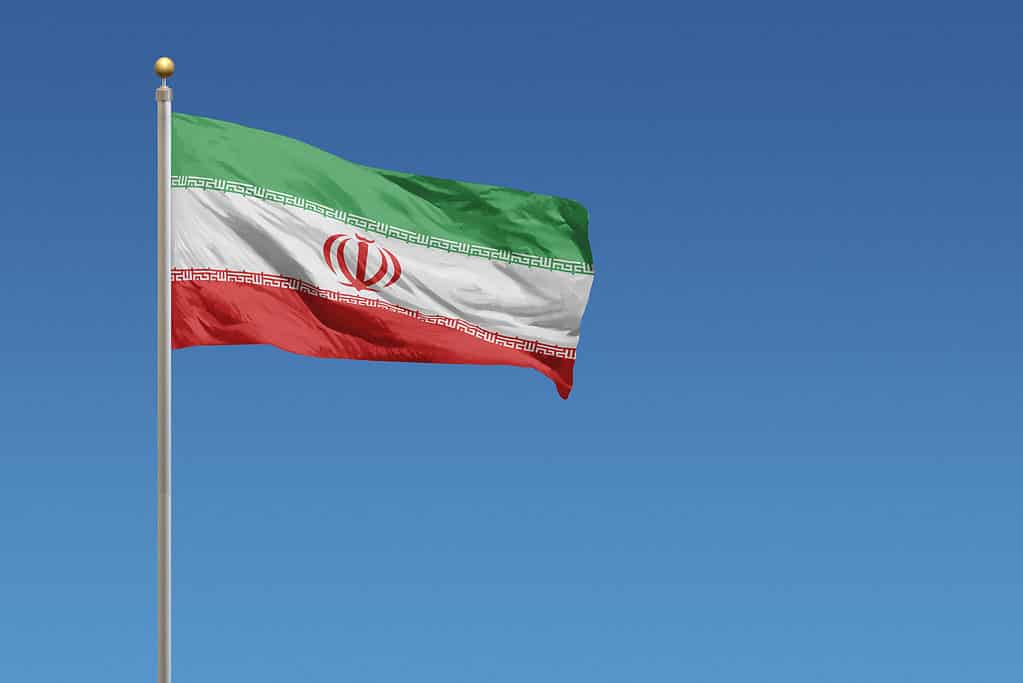The national flag has often been a significant symbol in Iranian politics and culture. The flag of Iran is distinctive in many ways, chief among them being that the Allāhu Akbar (God is great) feature at its center is unlike any other Islamic emblem (such as the crescent and star) and was invented from scratch to go with the revolutionary idea it would represent: an Islamic Republic. The three colors of the Iranian flag — white, green, and red — are deeply ingrained today, but there is very little information on how the sun and lion were replaced. So, what is the story behind the flag of Iran? This article explores the Iranian flag’s history, meaning, symbolism, and more.
Introduction to the Flag of Iran

The green color on the flag of Iran represents joy, oneness, nature, and progress.
©iStock.com/Derek Brumby
The flag of Iran is a tricolor with three evenly spaced bands of green, white, and red colors, with a height-to-length ratio of 1:2. In the center of the white band is the country’s crest, which is red and stylized to look like a tulip, a martyr’s flower, and contains the word, Allah. The flag also includes the Arabic salutation Allāhu Akbar, or Takbir. On the inside corners of the red and green bands, it is written in Kufic script 11 times.
The Colors of the Iranian Flag
The pre-revolutionary flag that is occasionally flown in protest and the official Iranian flag both have green, white, and red horizontal stripes. The flag’s colors, which have deep symbolic meaning and date to the middle of the 18th century, represent several characteristics of the Iranian people.
Islam is symbolized by the color green — thought to have been the Prophet Muhammad’s personal favorite — which appears on the flags of many Muslim nations, including Saudi Arabia, Algeria, and Pakistan. The color green on the flag represents joy, oneness, nature, and progress. According to British journalist Tim Marshall, red symbolizes martyrdom, bravery, fire, and love, while white stands for liberty.
The Iranian tricolor flag was formally established in the Constitution of 1906, despite earlier versions of the flag having used other colors.
What the Iranian Flag’s Emblem Means
One of Iran’s most cherished symbols, the Lion and Sun, or Shir o Khorshid, was replaced by the tulip motif in the middle of the current flag, a fairly recent modification.
The origins of the Lion and Sun symbol can be traced to Persia in the 12th century, where it became well known as a representation of the ancient star sign of the Sun under Leo, which undoubtedly stood for power and royalty. The Lion and Sun appeared on the nation’s flag throughout the succeeding centuries in various arrangements — sometimes as a representation of the foundations of society, the country, and religious practice, or as a monarchy icon.
But in 1979, the Iranian Revolution ended the monarchy by overthrowing Shah Mohammad Reza Pahlavi. To create a flag that would cut ties with the Shah and ensure a cultural history, the elected rulers of the Islamic Republic asked architect Hamid Nadimi to get the work done.
In 1980, Nadimi found a replacement for the Lion and Sun: a red tulip, which had long been significant in Shia Islam as a representation of Husayn Ibn Ali al-Hussein, the grandson of Muhammad who perished in a 7th-century battle as a martyr. Four half-moon petals and a single stem, or sword, that together form the word Allah and stand in for the five pillars of Islam make up this tulip.
Nadimi adorned the flag’s green and red stripes with stylized Arabic inscriptions that read Allahu Akbar (God is great).
Iranian Flag History

The current flag of Iran was established on July 29, 1980, following the Iranian Revolution of 1979.
©iStock.com/NatanaelGinting
In both times of war and peace, banners and flags have a long history in Iran, serving as significant national emblems. The tricolor of white, green, and red was layered over the sun and lion symbols, which remained the same with minor changes until the 1979 revolution.
The current flag was established on July 29, 1980, following the Iranian Revolution of 1979. The lion was associated with Ali being the first imam for the Shia branch of Islam, but the new Iranian government saw the sun and lion as representations of western monarchy and wanted them changed. Alternative flags are frequently flown by Iranian exiles who oppose the Iranian government, such as the tricolor Pahlavi flag with the Lion and Sun in the middle, or the tricolor with no added symbols. Some political organizations, the mujahedin, and communities of Iranian refugees fly the lion and sun flag.
The Flag of Iran Through the Years
Iranian history has seen flags and banners as representations of war and peace; even a golden eagle could be seen on one of the earliest flags. The following patterns were used from the 16th to the 18th centuries: a yellow circle atop a green field, a gold sun and lamb on a green field, and a gold lion and sun in the middle of a green field.
The initial design of the current flag was adopted in 1906, and the lion and sun symbol was in the middle of white, green, and red bands. In 1933 and 1964, this flag underwent modifications. Until the adoption of the current flag in 1980, this flag remained unaltered.
Up Next:
Every Flag in the World: Photos, History, and More
3 Countries With Animals on Their Flags, and Their Meaning
The ‘Join, or Die’ Flag vs. ‘Don’t Tread on Me’ Compared. History, Meaning, and More
The 10 Countries With Stars On Their Flags, and Their Meaning
Thank you for reading! Have some feedback for us? Contact the AZ Animals editorial team.








